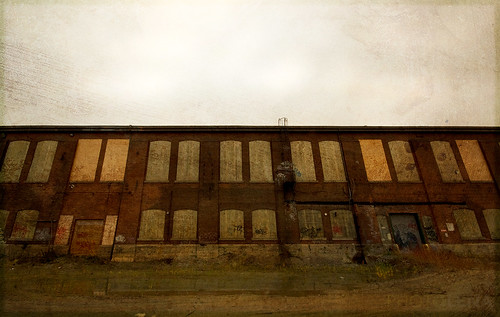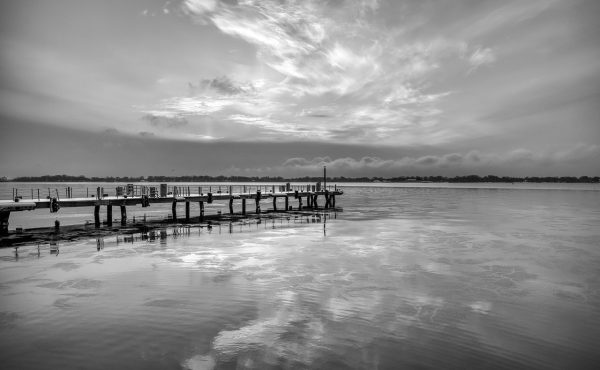
EDITOR’S NOTE: Spacing is pleased to again partner with Heritage Toronto on their upcoming Building Storeys exhibit at the Gladstone Hotel that runs from Feb. 4 to 27. A collaborative effort by Heritage Toronto and members of the photography groups the Shadow Collective and the DK Photo Group, Building Storeys is a visual documentation and anecdotal exhibit of the city’s heritage building and sites. This is the first in a series of posts on Spacing Toronto connected to the exhibit, and is by Derek Boles.
In 2010, the former Canadian Pacific Railway John Street roundhouse, a highly visible structure located adjacent to the Rogers Centre and the CN Tower, is being transformed into the Toronto Railway Heritage Centre. Eight kilometres to the north sits another considerably less conspicuous building that once performed a similar function to the downtown roundhouse. In the Leaside section of Toronto, northeast of Laird Drive and Esandar Drive, is the former Canadian Northern Railway Eastern Lines Locomotive Shop built in 1919. It’s hard to believe that this huge 92 x 46 meter building remained largely hidden away until 2006, when surrounding industrial buildings were demolished, clearly revealing the structure for the first time to passersby and residents west of Laird Drive.

The Locomotive Shop – present day ( top and above photos by Olena Sullivan)
Like the roundhouse, this building was designed to service steam locomotives, the form of motive power that hauled trains in and out of Toronto for over one hundred years. In 1915, the Canadian Northern Railway was one of Canada’s three transcontinental railways and the only one with headquarters in Toronto. The Canadian Pacific and Grand Trunk railways both maintained their head offices and principal shops in Montreal and they regarded Toronto as little more than a significant stop along the mainline to Chicago.
This 16,000-kilometre Canadian Northern rail system was built by two ambitious Toronto entrepreneurs named William Mackenzie and Donald Mann. At its height, the CNOR empire consisted of steam and electric railways, streetcar networks, a transatlantic steamship company, hotels, electrical transmission, mines, express services, grain elevators, irrigation and land development projects.
Mackenzie and Mann established the Canadian Northern Railway with headquarters on King Street in 1899. The first passenger trains between Toronto and Parry Sound began in November 1906 along the new line that the railway had built through the Don Valley. As the last major railway to enter Toronto, the CNOR could not obtain property close to Union Station to build terminal facilities so they purchased 110 acres of land in the Don Valley near Rosedale for a passenger yard and engine terminal.
By 1915, the CNOR had opened lines east through Scarborough to Ottawa, and north to Capreol where the railway connected with the transcontinental line between Quebec City and Vancouver. Hemmed in by the Don Valley, there was little room for the railway to expand its Rosedale facility as rail traffic increased. The Don River ran through the middle of the terminal and the low-lying flatland was prone to flooding in the spring. The noise and smoke led to frequent complaints from some of Toronto’s most influential citizens whose mansions overlooked the valley.

CNR Terminal — The Canadian Northern Leaside terminal is seen here shortly after completion by successor Canadian National Railways in the 1920s. The Eastern Lines Locomotive Shop can be seen on the upper left. There were 12 bays in this structure for locomotive maintenance and each engine was moved to the appropriate bay by the transfer table in front of the building. (Canada Science & Technology Museum: CN003958.)
Meanwhile Mackenzie and Mann had launched an ambitious Toronto real estate scheme. The partners purchased 1,000 acres of farmland several kilometres northeast of downtown. They planned on solving the problem of inadequate terminal facilities in Toronto by building their own new town. There would be plenty of room for offices, engine servicing facilities, repair shops, a roundhouse, marshalling yards and employee housing.
This community was incorporated as the town of Leaside and the partners proposed to pay for their new terminal by selling housing lots in a prestigious suburb that they advertised as the “new Rosedale.” To design Leaside, the partners brought in Frederick Todd, the Montreal landscape architect who had designed the Town of Mount Royal, another visionary and more successful Mackenzie and Mann scheme.
Mackenzie & Mann proposed several other grandiose schemes, including the Toronto, Niagara and Western Railway. This would connect Toronto with the Niagara frontier and the United States by using a section of the abandoned Toronto Belt Line Humber Loop in order to enter North Toronto from the west. The CNOR would build a 2,360-foot tunnel on the western approach to their new North Toronto station, which they planned on sharing with the Canadian Pacific Railway. A half-mile long tunnel under the city naturally precluded the use of steam locomotives so the railway planned to electrify their Toronto terminal operation. The noise and pollution generated by steam engines was a constant source of tension between Toronto residents and the railways. The Canadian Northern proposed to use quiet and non-polluting electric locomotives to haul their passenger trains in and out of Toronto.
However, there was trouble on the financial front for the Canadian Northern. Over the years, Mackenzie and Mann had persuaded financial backers to invest $300 million in the railway. Many of these investors were European and once World War I began, the flow of cash came to a halt. The Canadian Northern was repeatedly forced to ask for government assistance in order to keep operating. Finally in 1917, after it was concluded that the CNOR’s liabilities were worth more than its assets, the federal government nationalized the railway. The government was not only worried about the collapse of Canada’s third largest railway; the CNOR owed $10 million to the Toronto-based Bank of Commerce and Prime Minister Robert Borden was concerned about the stability of the bank.

Photo by Derek Boles
In 1919, the Canadian Northern, along with other bankrupt railways, became the foundation of the Canadian National Railways. The Leaside yards and shops were completed by the CNR in 1920 but the new consolidated railway found itself with many redundant facilities. The Leaside facility declined in importance after the CNR opened the Spadina yards and shops west of Union Station in 1927 and the repair shops closed in the 1930s.
The original Canadian Northern route between Toronto and Capreol became Canadian National’s Bala Subdivision and is now the main line between Toronto and western Canada. The GO train Richmond Hill line follows this route, as does the Ontario Northland train to North Bay and Cochrane and VIA Rail’s Canadian to Vancouver.
Two brick buildings survive from the Leaside facilities although all the tracks have been lifted. In addition to the engine house, on the south side of Esandar Drive is a smaller structure that was used as the stores building and is now occupied by an automobile mechanic.
The Locomotive Shop is designated under the Ontario Heritage Act and there are future plans for redevelopment.
Derek Boles is one of the founding members of the Toronto Railway Historical Association and is the author of a new book, Toronto’s Railway Heritage. For the past few years, he has coordinated the annual Doors Open event at Union Station. He also leads popular monthly tours of the station that have attracted over 1,000 people since they began in 2006. Mr. Boles is also a member of the Heritage Toronto Board and is the Chair of the Union Station Revitalization Public Advisory Group.




11 comments
Nicely done — I learned a lot.
For those interested in the Canadian Northern Railway and it’s history check out The railway Museum of Eastern Ontario and or the Canadian Northern Society.
Generally speaking, I feel that while rudiments remain, “industrial Leaside” was a tragic lost opportunity for a King/Dufferin/Liberty Village zone of post-industrial renewal–too many big boxes, too much unnecessary demolition, perhaps too many myopic middlebrow-Pitfieldite “heritage buffs” who love residential Leaside too much to heed the sublime virtues of industrial Leaside…
Wow! I’m a foamer & I didn’t even know about this! Thx Derek!
Derek’s tours of Union Station are well worth it, even for non-foamers. History, architecture, design, business, Toronto politics, it’s a great story
Where did this half-mile long tunnel run, and what happened to it?
Where did this half-mile long tunnel run, and what happened to it?
Comment by Laurie
January 29, 2010 @ 11:34 am
The tunnel was never built. The west portal would have been located south of St. Clair Avenue on Talbot Street just west of the GO line to Barrie; the east portal would have been near Davenport Rd. and Primrose Avenue.
Derek Boles
It’s great that some of these valuable heritage buildings remain in Leaside. In the Junction, over the decades all railway buildings were lost: two roundhouses, all shops, and a passenger railway station.
The roundhouse’s turntable has been preserved along with some wooden structure and can be found near the tracks in Rona’s parking lot. It’s now deteriorating.
Its too bad the car dealership proposal for the site has died. The locomotive shop was proposed to be retained, restored, and incorporated into two new dealerships as the car service shop. Customers would have be able to sit in a mezzanine lounge above the main floor overlooking the vast service bay. It would have been a great way to continue the building’s use instead of being an abandoned canvass for graffiti artists and vandals as it exists today.
http://www.toronto.ca/legdocs/mmis/2008/ny/bgrd/backgroundfile-9499.pdf
Thanks for a very interesting article. Can you shed some light on what the current redevelopment plans for the site are?
I don’t know what the status of the car dealership redevelopment proposal is at the present time. My understanding is that it was connected with Roy Foss, a well known GM dealer in the Toronto area. I can understand why a GM dealer would be curtailing expansion plans at the present time.
I agree that it would be a good use for the property. I believe that retail is generally a good fit for a heritage property. It means that the property is open and accessible for many hours a day, like the Leon’s at the roundhouse downtown.
But I’m not sure about the idea to turn it into just a car service shop. I’d think that the grand space would be more impressive as the showroom.